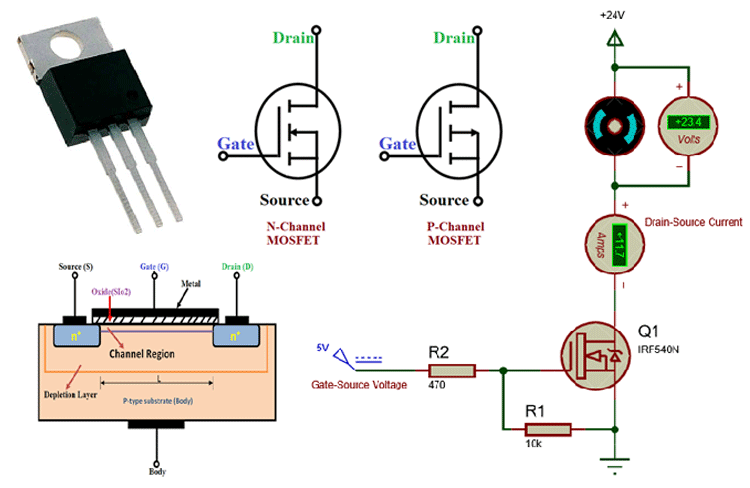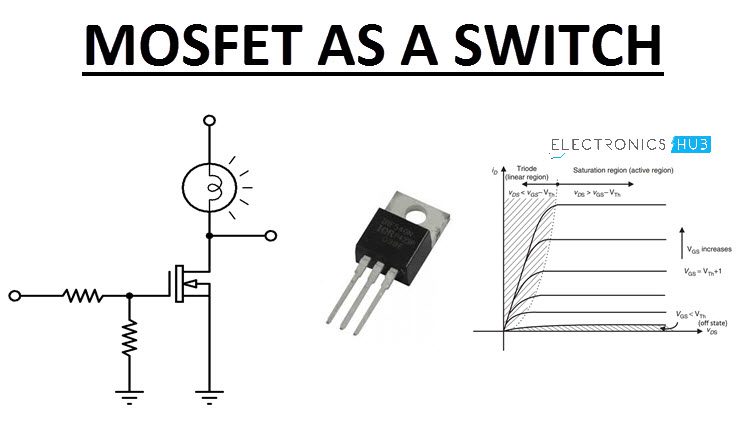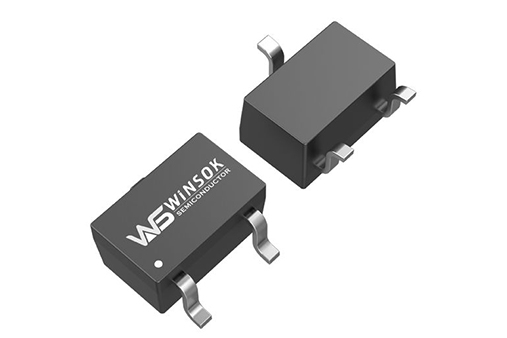Understanding MOSFET Basics
 MOSFETs have revolutionized the electronics industry since their invention in 1959. Unlike their bipolar transistor predecessors, MOSFETs offer superior power efficiency, faster switching speeds, and simpler drive requirements. These characteristics make them indispensable in modern electronic design.
MOSFETs have revolutionized the electronics industry since their invention in 1959. Unlike their bipolar transistor predecessors, MOSFETs offer superior power efficiency, faster switching speeds, and simpler drive requirements. These characteristics make them indispensable in modern electronic design.
MOSFET Structure and Types
A MOSFET consists of three main terminals: the Source (S), Drain (D), and Gate (G). Some packages also include a fourth terminal connected to the substrate or case, called the Body (B) or bulk connection. There are two primary types of MOSFETs:
- N-channel MOSFETs (NMOS): The majority carriers are electrons, and the device turns on with a positive gate voltage
- P-channel MOSFETs (PMOS): The majority carriers are holes, and the device turns on with a negative gate voltage
| Parameter | N-Channel MOSFET | P-Channel MOSFET |
|---|---|---|
| Turn-on Voltage | Positive Gate Voltage | Negative Gate Voltage |
| Switching Speed | Faster | Slower |
| On-Resistance | Lower | Higher |
| Cost | Lower | Higher |
Practical Applications of MOSFETs
Switching Power Supplies
 One of the most common applications of MOSFETs is in switching power supplies (SMPS). These devices are essential in modern electronics, providing efficient power conversion for countless devices. The MOSFET’s fast switching capabilities and low on-resistance make it ideal for this application.
One of the most common applications of MOSFETs is in switching power supplies (SMPS). These devices are essential in modern electronics, providing efficient power conversion for countless devices. The MOSFET’s fast switching capabilities and low on-resistance make it ideal for this application.
Key Design Considerations for SMPS:
- Select MOSFETs with low RDS(on) to minimize conduction losses
- Consider the maximum voltage and current ratings with adequate safety margins
- Pay attention to the gate charge (Qg) for efficient switching
- Implement proper thermal management and heat dissipation
Motor Control Applications
MOSFETs excel in motor control applications, from small DC motors to large industrial drives. Their ability to handle high currents and fast switching makes them perfect for Pulse Width Modulation (PWM) control.
| Motor Type | MOSFET Configuration | Key Requirements |
|---|---|---|
| DC Motors | H-Bridge | Low RDS(on), Fast switching |
| BLDC Motors | Three-phase bridge | Matched characteristics, Low switching losses |
| Stepper Motors | Dual H-Bridge | High current capability, Good thermal performance |
Best Practices for MOSFET Implementation
Gate Drive Considerations
Proper gate driving is crucial for optimal MOSFET performance. A well-designed gate drive circuit ensures efficient switching and prevents damage to the device.
Essential Gate Drive Guidelines:
- Use appropriate gate voltage levels (typically 10-12V for logic-level MOSFETs)
- Include gate resistors to control switching speed and prevent ringing
- Consider using gate drivers for high-frequency applications
- Implement protection against voltage spikes and oscillations
Thermal Management
Effective thermal management is critical for MOSFET reliability. Even with their high efficiency, MOSFETs still generate heat that must be properly dissipated.
Thermal Design Tips:
- Calculate maximum power dissipation under worst-case conditions
- Select appropriate heatsinks based on thermal resistance requirements
- Use thermal paste or pads for better heat transfer
- Consider forced air cooling for high-power applications
Why Choose Winsok MOSFETs?
As the official distributor of Winsok, Olukey offers high-quality MOSFETs that deliver exceptional performance and reliability. Winsok’s advanced manufacturing processes and rigorous quality control ensure:
- Superior switching characteristics
- Excellent thermal performance
- Competitive pricing
- Comprehensive technical support
Troubleshooting Common MOSFET Issues
 When working with MOSFETs, you may encounter various issues. Here are some common problems and their solutions:
When working with MOSFETs, you may encounter various issues. Here are some common problems and their solutions:
| Issue | Possible Causes | Solutions |
|---|---|---|
| Overheating | High switching losses, inadequate cooling | Improve heat sinking, reduce switching frequency |
| Poor switching | Inadequate gate drive, parasitic effects | Optimize gate drive circuit, improve layout |
| Device failure | Voltage spikes, thermal runaway | Add snubbers, improve thermal management |
Need Professional Support?
Olukey’s team of experts is ready to help you select the right MOSFETs for your application and provide technical support throughout your design process.
Remember, selecting the right MOSFET is crucial for your application’s success. Consider working with reliable suppliers like Olukey to ensure you get high-quality components and expert support for your projects.
























